Craving bold, vibrant flavors that tell a story? Dive into the rich culinary traditions of the Hmong community with these 19 Authentic Hmong Recipes—each one a delicious celebration of fresh herbs, aromatic spices, and comforting textures. From sizzling stir-fries to soul-warming soups, these dishes are perfect for adventurous home cooks ready to bring something new (and seriously tasty) to the table. Let’s get cooking!
Hmong Sticky Rice with Mango
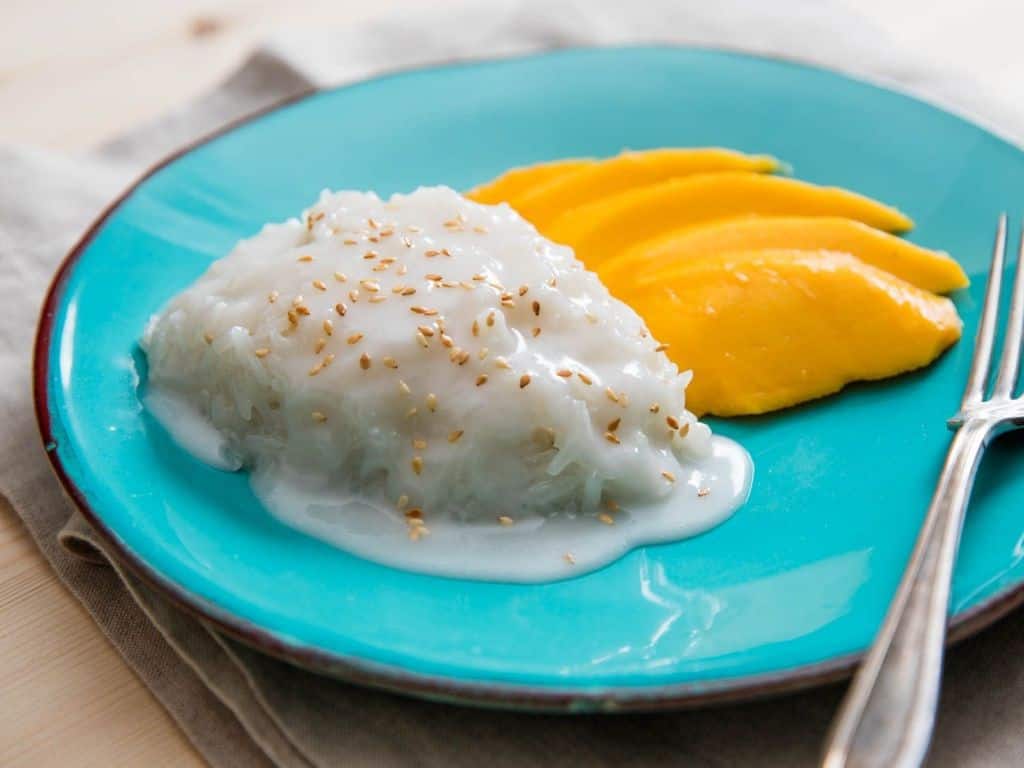
This fragrant, slightly sweet sticky rice is a comforting treat—paired with ripe mango, it’s a match made in tropical heaven.
Ingredients:
- 1 cup glutinous (sticky) rice, soaked overnight
- 1 (13.5 oz) can coconut milk
- 1/4 cup granulated sugar
- 1/2 tsp salt
- 2 ripe mangoes, peeled and sliced
- 1 tbsp toasted sesame seeds (optional)
Instructions:
- Drain the soaked sticky rice and steam in a bamboo steamer or sieve lined with cheesecloth over boiling water for 25 minutes, until tender and glossy.
- While the rice cooks, warm the coconut milk, sugar, and salt in a small saucepan over medium heat, stirring until the sugar dissolves (about 3 minutes). Remove from heat.
- Transfer the cooked rice to a bowl and gently fold in the coconut milk mixture until fully absorbed. Let rest for 10 minutes to soak up the flavors.
- Serve warm, topped with mango slices and a sprinkle of sesame seeds if using.
The magic here is in the rice’s chewy texture and coconut richness—it clings to the mango like a sweet, creamy hug.
Tip: For extra fragrance, add a pandan leaf to the coconut milk while heating (remove before mixing).
Hmong Spicy Papaya Salad

This vibrant, tangy salad packs a punch with fresh green papaya, fiery chiles, and a savory-sweet dressing—perfect for those who love bold flavors!
Ingredients:
- 1 small green papaya (about 2 cups shredded)
- 2 cloves garlic, minced
- 1–2 Thai bird’s eye chiles, finely chopped (adjust to taste)
- 2 tbsp fish sauce
- 2 tbsp lime juice
- 1 tbsp palm sugar (or brown sugar)
- 1/4 cup cherry tomatoes, halved
- 2 tbsp crushed roasted peanuts
- 1/4 cup fresh cilantro, roughly chopped
Instructions:
- Peel and shred the green papaya using a julienne peeler or grater. Place in a large bowl.
- In a small bowl, whisk together 2 tbsp fish sauce, 2 tbsp lime juice, and 1 tbsp palm sugar until the sugar dissolves.
- Add the minced garlic and chopped chiles to the dressing, then pour over the shredded papaya. Toss well to coat.
- Gently fold in the cherry tomatoes and half of the cilantro. Let sit for 10 minutes to let the flavors meld.
- Top with crushed peanuts and remaining cilantro before serving.
The magic here is in the contrast: crunchy papaya soaks up the spicy-sour dressing, while peanuts add a toasty finish.
Tip: For extra crunch, toss in a handful of green beans or shredded carrots!
Hmong Chicken Curry with Coconut Milk
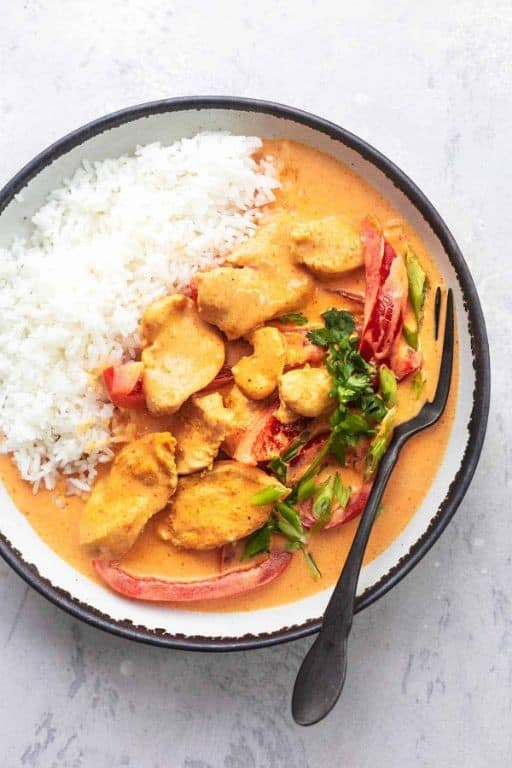
This fragrant, creamy curry balances bold spices with the richness of coconut milk—a comforting dish that’s perfect for weeknights but special enough for guests.
Ingredients:
- 1.5 lbs boneless, skinless chicken thighs, cut into 1-inch pieces
- 1 tbsp vegetable oil
- 1 medium yellow onion, thinly sliced
- 3 garlic cloves, minced
- 1 tbsp grated ginger
- 2 tbsp red curry paste
- 1 tsp ground turmeric
- 1 (13.5-oz) can full-fat coconut milk
- 1 cup chicken broth
- 1 tbsp fish sauce
- 1 tsp sugar
- 1/2 tsp salt
- 1 red bell pepper, sliced
- Fresh cilantro and lime wedges (for serving)
Instructions:
- Heat 1 tbsp vegetable oil in a large pot over medium-high. Add chicken and cook until lightly browned, about 5 minutes. Transfer to a plate.
- In the same pot, sauté onion for 3 minutes until soft. Add 3 garlic cloves, 1 tbsp ginger, 2 tbsp red curry paste, and 1 tsp turmeric; cook 1 minute until fragrant.
- Pour in 1 can coconut milk and 1 cup chicken broth, scraping up any browned bits. Stir in 1 tbsp fish sauce, 1 tsp sugar, and 1/2 tsp salt.
- Return chicken to the pot, add bell pepper, and simmer uncovered for 15–20 minutes until chicken is tender and sauce thickens slightly.
- Garnish with cilantro and serve with lime wedges.
The magic here? The turmeric and curry paste create a vibrant golden sauce that clings to every bite, while coconut milk keeps it luxuriously smooth.
Tip: For extra depth, toast 1 tsp cumin seeds with the curry paste in step 2.
Hmong Steamed Fish with Lemongrass

This fragrant, tender steamed fish is packed with bright lemongrass and herb flavors—a simple yet showstopping dish for weeknights or gatherings.
Ingredients:
- 1 whole white fish (like tilapia or cod, about 1.5 lbs), cleaned and scored
- 3 stalks lemongrass, bruised and cut into 2-inch pieces
- 3 cloves garlic, minced
- 1-inch knob ginger, julienned
- 2 tbsp soy sauce
- 1 tbsp fish sauce
- 1 tsp sugar
- 1/2 tsp black pepper
- 1/4 cup fresh cilantro, chopped
- 2 green onions, sliced
- 1 tbsp neutral oil (like avocado or grapeseed)
Instructions:
- In a bowl, mix 3 cloves minced garlic, 1-inch julienned ginger, 2 tbsp soy sauce, 1 tbsp fish sauce, 1 tsp sugar, and 1/2 tsp black pepper to make the marinade.
- Place the fish on a heatproof plate and rub the marinade inside the cavity and over the scored skin. Tuck 3 stalks lemongrass around the fish.
- Set up a steamer (or a rack in a wok with boiling water) and steam the fish over high heat for 12–15 minutes until opaque and flaky.
- Heat 1 tbsp neutral oil in a small pan until shimmering, then drizzle it over the cooked fish. Garnish with 1/4 cup cilantro and 2 sliced green onions.
The lemongrass infuses the fish with a citrusy aroma while keeping it incredibly moist—no dry, overcooked bites here!
Tip: For extra flavor, stuff the fish with a few makrut lime leaves or Thai basil sprigs before steaming.
Hmong Pork Belly with Basil
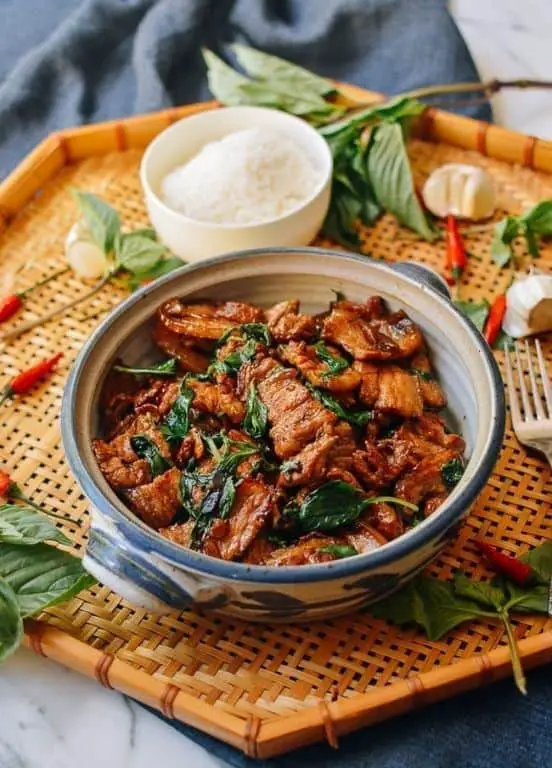
This fragrant, savory-sweet pork belly dish is a Hmong staple, featuring crispy-edged meat tossed with fresh basil and a punchy garlic-chili sauce.
Ingredients
- 1.5 lbs pork belly, sliced into ½-inch thick strips
- 3 tbsp neutral oil (like vegetable or avocado)
- 5 cloves garlic, minced
- 2 tbsp soy sauce
- 1 tbsp oyster sauce
- 1 tbsp brown sugar
- ½ tsp black pepper
- 1-2 Thai chilies (or ½ tsp red pepper flakes), finely chopped
- 1 cup fresh basil leaves (Thai holy basil preferred, but Italian works)
Instructions
- Heat oil in a large skillet over medium-high. Add pork belly and cook, stirring occasionally, for 8–10 minutes until browned and crispy at the edges.
- Push pork to one side. Add minced garlic and chilies to the empty space and sauté for 30 seconds until fragrant.
- Stir in soy sauce, oyster sauce, brown sugar, and black pepper. Toss everything together and cook for 2 minutes to coat the pork.
- Remove from heat and immediately fold in basil leaves until just wilted.
The magic here is the contrast: crackly pork, sticky-sweet glaze, and that peppery basil freshness cutting through it all.
Tip: For extra crispiness, pat the pork belly dry with paper towels before cooking.
Hmong Beef Jerky
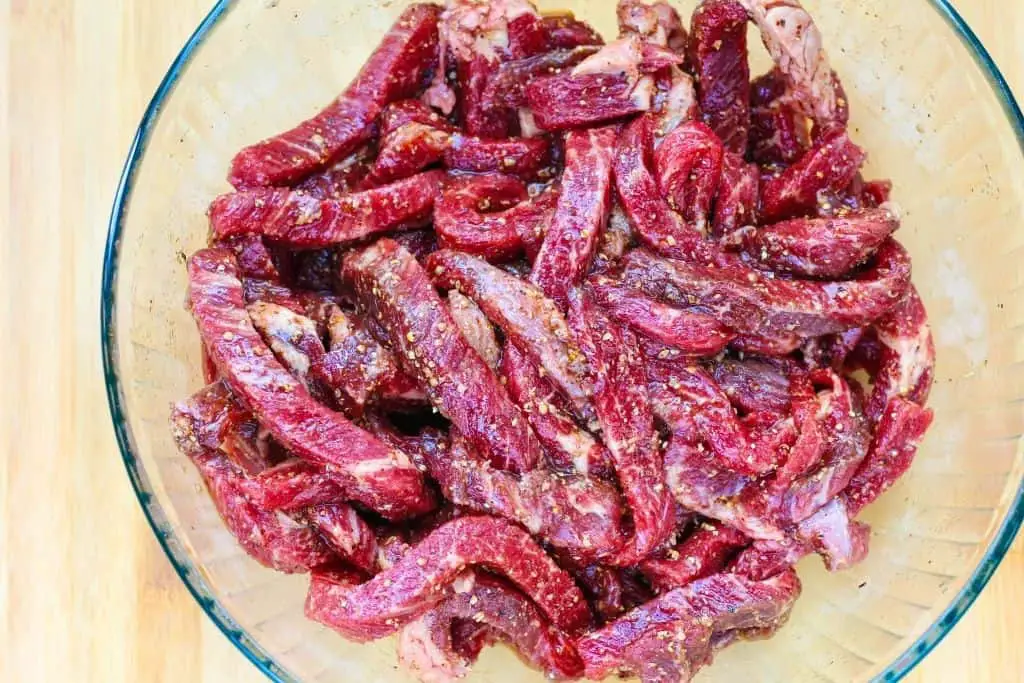
This bold, sweet-and-spicy Hmong beef jerky is a crave-worthy snack that’s surprisingly simple to make at home—no dehydrator required!
Ingredients:
- 1 lb flank steak, thinly sliced against the grain
- 3 tbsp soy sauce
- 2 tbsp fish sauce
- 2 tbsp honey
- 1 tbsp sriracha
- 1 tsp garlic powder
- 1 tsp black pepper
- 1/2 tsp red pepper flakes
Instructions:
- In a bowl, whisk together 3 tbsp soy sauce, 2 tbsp fish sauce, 2 tbsp honey, 1 tbsp sriracha, 1 tsp garlic powder, 1 tsp black pepper, and 1/2 tsp red pepper flakes until smooth.
- Add flank steak to the marinade, tossing to coat. Cover and refrigerate for at least 4 hours (or overnight for deeper flavor).
- Preheat oven to 175°F. Arrange marinated steak in a single layer on a wire rack set over a baking sheet.
- Bake for 4–5 hours, flipping halfway, until dry but still slightly pliable. Let cool completely before serving.
The magic here? The marinade caramelizes into a glossy, sticky-sweet crust while keeping the jerky tender inside—no toughness here!
Tip: For extra chew, slice the steak slightly thicker (1/4 inch); for crispier edges, go thinner (1/8 inch).
Hmong Fermented Mustard Greens
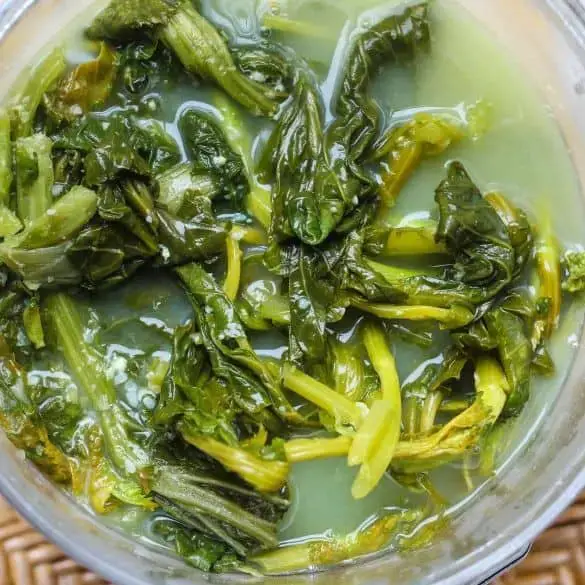
Tangy, crunchy, and packed with umami, these fermented mustard greens are a staple in Hmong cuisine—perfect for adding a punch to soups, stir-fries, or even enjoying as a side.
Ingredients:
- 2 lbs mustard greens, washed and roughly chopped
- 3 tbsp kosher salt
- 4 cups filtered water
- 1 tbsp sugar
- 3 cloves garlic, smashed
- 1–2 Thai chiles (optional, for heat)
Instructions:
- Prep the greens: In a large bowl, toss the mustard greens with 2 tbsp of the kosher salt until evenly coated. Let sit for 20 minutes to draw out moisture, then rinse and drain well.
- Make the brine: In a pot, heat the filtered water with the remaining 1 tbsp salt and 1 tbsp sugar until dissolved. Cool completely.
- Pack the jar: Tightly layer the greens, garlic, and chiles (if using) in a clean 1-quart mason jar. Pour the cooled brine over, ensuring greens are fully submerged. Weigh them down with a fermentation weight or small clean plate.
- Ferment: Cover loosely with a lid or cloth and store at room temperature (68–75°F) for 3–5 days. Taste daily until tangy and slightly fizzy. Transfer to the fridge to slow fermentation; it’ll keep for months.
The magic here is in the slow fermentation—it transforms humble greens into a complex, sour-savory condiment with a satisfying crunch.
Tip: For extra funk, add a splash of fish sauce to the brine before fermenting.
Hmong Stuffed Bitter Melon

Hmong Stuffed Bitter Melon is a comforting dish that balances earthy bitterness with savory pork filling—perfect for adventurous home cooks looking to explore Southeast Asian flavors.
- 2 medium bitter melons (about 1 lb total)
- 1 lb ground pork
- 1/4 cup finely chopped shallots
- 2 cloves garlic, minced
- 1 tbsp fish sauce
- 1 tsp sugar
- 1/2 tsp black pepper
- 1 tbsp vegetable oil
- 1 cup chicken broth
- 2 green onions, thinly sliced (for garnish)
- Cut bitter melons crosswise into 2-inch segments. Scoop out seeds with a spoon, leaving hollow tubes.
- In a bowl, combine ground pork, shallots, garlic, fish sauce, sugar, and black pepper. Mix until sticky.
- Stuff each melon segment tightly with pork mixture, pressing to seal the ends.
- Heat vegetable oil in a skillet over medium. Sear stuffed melon, turning occasionally, until golden (about 3 minutes per side).
- Pour in chicken broth, cover, and simmer for 20 minutes until melon is tender and pork is cooked through.
- Garnish with green onions and serve warm.
The magic here? The broth softens the melon’s bite while the pork filling soaks up all that umami-rich flavor. Tip: For less bitterness, soak melon segments in salted water for 10 minutes before stuffing.
Hmong Herb-infused Chicken Soup
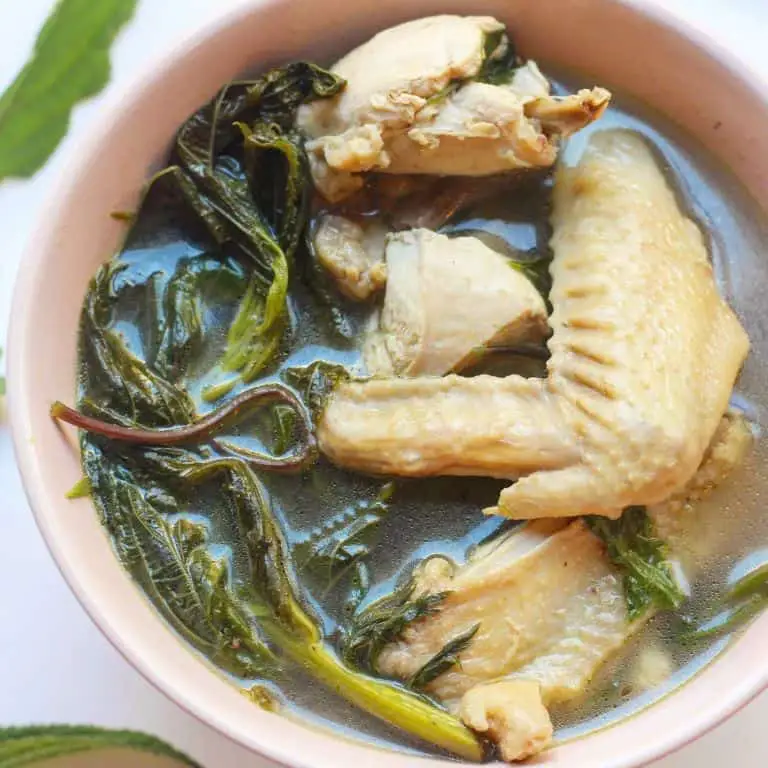
This soul-warming soup is packed with fragrant herbs and tender chicken—a comforting bowl that’s as nourishing as it is flavorful.
Ingredients:
- 1 whole (3–4 lb) chicken, cut into 8 pieces
- 8 cups water
- 1 tbsp salt
- 1 tbsp chicken bouillon powder
- 1 tbsp vegetable oil
- 4 garlic cloves, minced
- 1 bunch (about 2 cups) fresh culantro (or cilantro if unavailable), chopped
- 1 bunch (about 1 cup) green onions, sliced
- 1 (2-inch) piece ginger, thinly sliced
- 1 tbsp fish sauce
- 1 tsp black pepper
Instructions:
- In a large pot, heat 1 tbsp vegetable oil over medium heat. Add garlic and ginger, sautéing for 1 minute until fragrant.
- Add chicken pieces and sear for 3–4 minutes per side until lightly browned.
- Pour in 8 cups water, then stir in 1 tbsp salt, 1 tbsp chicken bouillon powder, and 1 tsp black pepper. Bring to a boil, then reduce heat to low and simmer for 30 minutes, skimming foam occasionally.
- Add culantro, green onions, and 1 tbsp fish sauce. Simmer for another 10 minutes until herbs wilt and chicken is fully cooked.
- Adjust seasoning to taste and serve hot.
The magic here? The herbaceous punch of culantro and ginger—it’s bright, aromatic, and utterly addictive.
Tip: For extra depth, char the ginger slices lightly in a dry pan before adding them to the soup.
Hmong Grilled Pork Skewers

These tender, flavor-packed skewers are a staple of Hmong cuisine, featuring a sweet-savory marinade that caramelizes beautifully on the grill.
Ingredients:
- 1.5 lbs pork shoulder, cut into 1-inch cubes
- 3 tbsp soy sauce
- 2 tbsp fish sauce
- 2 tbsp honey
- 4 garlic cloves, minced
- 1 tbsp grated ginger
- 1 tsp black pepper
- 1/4 cup chopped cilantro (for garnish)
- Bamboo skewers, soaked in water for 30 minutes
Instructions:
- In a bowl, whisk together 3 tbsp soy sauce, 2 tbsp fish sauce, 2 tbsp honey, 4 minced garlic cloves, 1 tbsp grated ginger, and 1 tsp black pepper.
- Add pork cubes to the marinade, tossing to coat. Cover and refrigerate for at least 2 hours (or overnight for deeper flavor).
- Thread marinated pork onto soaked skewers, leaving small gaps between pieces.
- Preheat grill to medium-high (400°F). Grill skewers for 3-4 minutes per side, basting with leftover marinade, until slightly charred and cooked through.
- Garnish with 1/4 cup chopped cilantro before serving.
The magic here is in the marinade—fish sauce adds umami depth while honey creates those irresistible crispy edges. Tip: For extra tenderness, use pork shoulder with a bit of fat marbling.
Hmong Stir-fried Glass Noodles
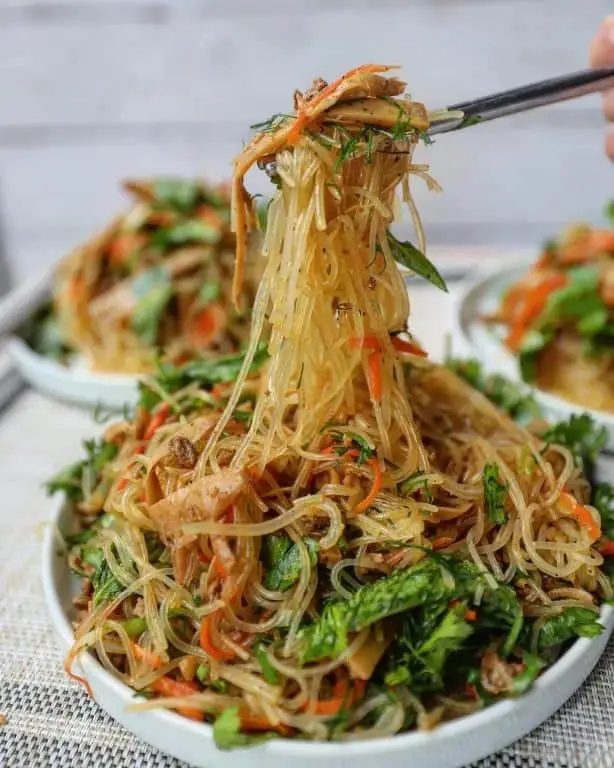
This vibrant stir-fry combines chewy glass noodles with crisp veggies and savory-sweet flavors—a quick weeknight dish that’s packed with texture.
Ingredients
- 4 oz dried glass noodles (bean threads)
- 2 tbsp vegetable oil, divided
- 2 cloves garlic, minced
- 1/2 lb ground pork (or chicken)
- 1 cup shredded carrots
- 1 cup thinly sliced bell peppers (any color)
- 2 tbsp soy sauce
- 1 tbsp oyster sauce
- 1 tsp sugar
- 1/4 tsp black pepper
- 2 green onions, sliced
Instructions
- Soak noodles: Cover glass noodles in hot water for 10 minutes until pliable. Drain and snip into shorter strands with scissors.
- Sauté aromatics: Heat 1 tbsp oil in a wok or large skillet over medium-high. Add garlic and cook for 30 seconds until fragrant.
- Cook pork: Add ground pork, breaking it up with a spatula. Stir-fry for 3–4 minutes until no pink remains.
- Add veggies: Toss in carrots and bell peppers. Cook for 2 minutes until slightly softened.
- Season: Push ingredients to one side. Pour remaining 1 tbsp oil into the empty space, then add soy sauce, oyster sauce, sugar, and black pepper. Stir to combine.
- Toss with noodles: Add drained noodles and green onions. Use tongs to fold everything together for 2 minutes until noodles absorb the sauce.
The magic here? Glass noodles stay springy while soaking up every bit of that glossy, umami-rich sauce. Serve with extra green onions for a fresh crunch.
Tip: For extra kick, stir in 1 tsp sambal oelek with the sauces.
Hmong Eggplant with Garlic and Chili
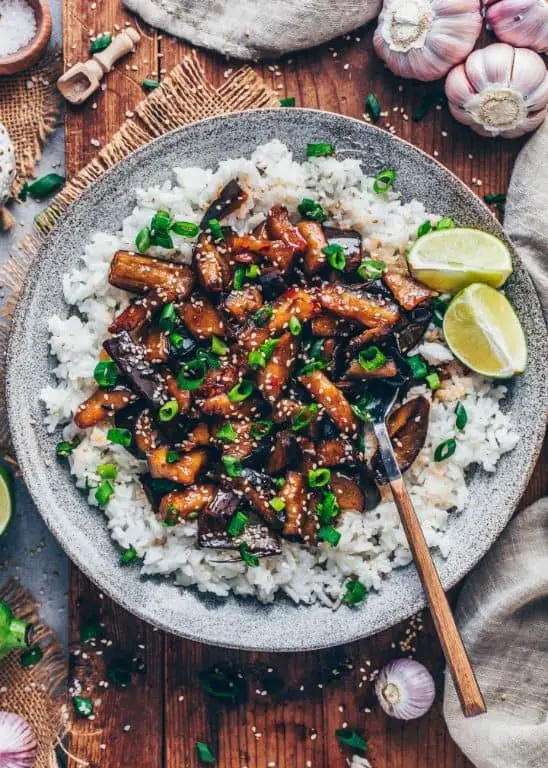
This fragrant stir-fry is a Hmong staple—smoky eggplant meets punchy garlic and chili for a dish that’s bold yet comforting.
Ingredients
- 1 lb Chinese or Japanese eggplant, cut into 2-inch wedges
- 3 tbsp neutral oil (like avocado or vegetable), divided
- 5 garlic cloves, minced
- 1–2 Thai chilies (or 1 serrano), thinly sliced
- 1 tbsp oyster sauce
- 1 tbsp soy sauce
- 1 tsp sugar
- 1/4 cup water
- 1/4 cup cilantro, chopped
Instructions
- Heat 2 tbsp oil in a wok or skillet over medium-high. Add eggplant and stir-fry for 5–6 minutes until lightly charred and tender. Transfer to a plate.
- Reduce heat to medium, add 1 tbsp oil, then sauté garlic and chilies for 30 seconds until fragrant.
- Return eggplant to the pan. Add oyster sauce, soy sauce, sugar, and water. Toss to coat and simmer for 2 minutes until sauce thickens slightly.
- Off heat, stir in cilantro. Serve warm.
The magic here? The eggplant soaks up the garlicky-chili sauce while keeping its creamy texture—no mushiness in sight.
Tip: For extra smokiness, char the eggplant directly over a gas flame for 1–2 minutes before slicing.
Hmong Sweet Rice Balls in Coconut Milk

These chewy, fragrant rice balls swimming in creamy coconut milk are a comforting treat—like a warm hug in a bowl.
Ingredients:
- 1 cup glutinous rice flour
- 1/2 cup warm water
- 1 (13.5 oz) can coconut milk
- 1/4 cup sugar
- 1/4 tsp salt
- 1/4 cup shredded coconut (toasted, for garnish)
Instructions:
- In a bowl, mix glutinous rice flour and warm water until a smooth dough forms. Roll into 1-inch balls (about 12 total).
- Bring a pot of water to a boil. Gently drop rice balls in and cook for 3–4 minutes until they float. Remove with a slotted spoon.
- In a saucepan, combine coconut milk, sugar, and salt. Simmer over medium-low heat for 5 minutes, stirring until sugar dissolves.
- Divide rice balls into bowls, pour warm coconut milk over, and sprinkle with toasted shredded coconut.
The magic here? The rice balls stay delightfully springy even in the rich coconut broth—perfect for savoring slowly.
Tip: Toast the shredded coconut in a dry pan over low heat for 2 minutes to deepen its nutty flavor.
Hmong Cabbage and Pork Stew

This comforting stew balances tender pork and sweet cabbage in a fragrant, slightly spicy broth—perfect for chilly nights when you crave something hearty but simple.
Ingredients:
- 1 lb pork shoulder, cut into 1-inch cubes
- 1 small green cabbage (about 2 lbs), roughly chopped
- 3 cloves garlic, minced
- 1 tbsp ginger, grated
- 2 tbsp vegetable oil
- 4 cups chicken broth
- 2 tbsp soy sauce
- 1 tbsp fish sauce
- 1 tsp sugar
- 1/2 tsp black pepper
- 1/2 tsp red pepper flakes (optional)
- 2 green onions, sliced (for garnish)
Instructions:
- Heat vegetable oil in a large pot over medium-high. Add pork shoulder and sear until browned, about 5 minutes.
- Stir in garlic and ginger, cooking for 1 minute until fragrant. Pour in chicken broth, soy sauce, fish sauce, sugar, black pepper, and red pepper flakes (if using). Bring to a boil, then reduce heat to low and simmer for 30 minutes.
- Add cabbage, stirring to submerge. Cover and simmer for another 20 minutes until cabbage is tender but still slightly crisp.
- Garnish with green onions before serving.
The magic here? The cabbage soaks up the savory-sweet broth while keeping its texture, making every bite satisfying.
Tip: For extra depth, char the cabbage wedges in a dry skillet before adding them to the stew.
Hmong Fried Spring Rolls

These crispy, savory spring rolls are packed with aromatic herbs and ground pork—a Hmong staple that’s perfect for sharing (or not!).
Ingredients
- 1 lb ground pork
- 2 cups shredded cabbage
- 1 cup shredded carrots
- 1/2 cup chopped green onions
- 1/4 cup chopped cilantro
- 2 cloves garlic, minced
- 1 tbsp soy sauce
- 1 tsp salt
- 1/2 tsp black pepper
- 1 package (12 oz) spring roll wrappers
- 1 egg, beaten (for sealing)
- 2 cups vegetable oil (for frying)
Instructions
- In a large bowl, combine ground pork, cabbage, carrots, green onions, cilantro, garlic, soy sauce, salt, and black pepper. Mix until evenly distributed.
- Lay a spring roll wrapper diagonally on a clean surface. Spoon 2 tbsp of filling near the bottom corner, then fold the corner over the filling. Fold in the sides and roll tightly, sealing the edge with beaten egg.
- Heat vegetable oil in a deep skillet to 350°F over medium heat. Fry rolls in batches for 3–4 minutes, turning occasionally, until golden brown and crispy. Drain on paper towels.
The magic here? The fresh cilantro and green onions add a bright, herbal punch that balances the rich pork—no dipping sauce needed!
Tip: Keep unused wrappers covered with a damp towel to prevent cracking while you work.
Hmong Bamboo Shoot Salad
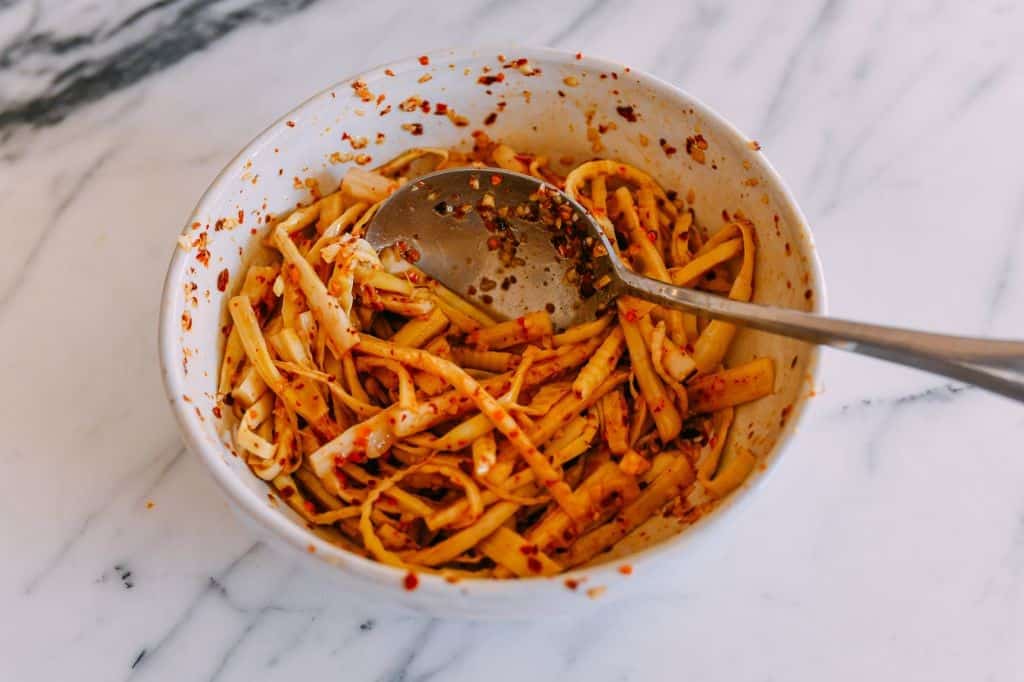
Bright, tangy, and crunchy, this refreshing salad is a vibrant way to enjoy bamboo shoots with a kick of Southeast Asian flavors.
Ingredients:
- 2 cups shredded bamboo shoots (canned or pre-boiled, drained well)
- 1/4 cup thinly sliced red onion
- 1/4 cup chopped cilantro
- 1 tbsp toasted sesame seeds
- 2 tbsp lime juice
- 1 tbsp fish sauce
- 1 tbsp honey
- 1/2 tsp red pepper flakes
- 1/4 tsp salt
Instructions:
- In a large bowl, toss bamboo shoots, red onion, and cilantro.
- In a small bowl, whisk lime juice, fish sauce, honey, red pepper flakes, and salt until smooth.
- Pour dressing over the salad and toss to coat evenly. Let sit for 10 minutes to meld flavors.
- Sprinkle with toasted sesame seeds just before serving.
The contrast of crisp bamboo shoots with the zesty-sweet dressing makes this salad addictive—perfect for picnics or as a side to grilled meats.
Tip: For extra crunch, add 1/4 cup crushed roasted peanuts with the sesame seeds.
Hmong Lemongrass Beef Stir-fry
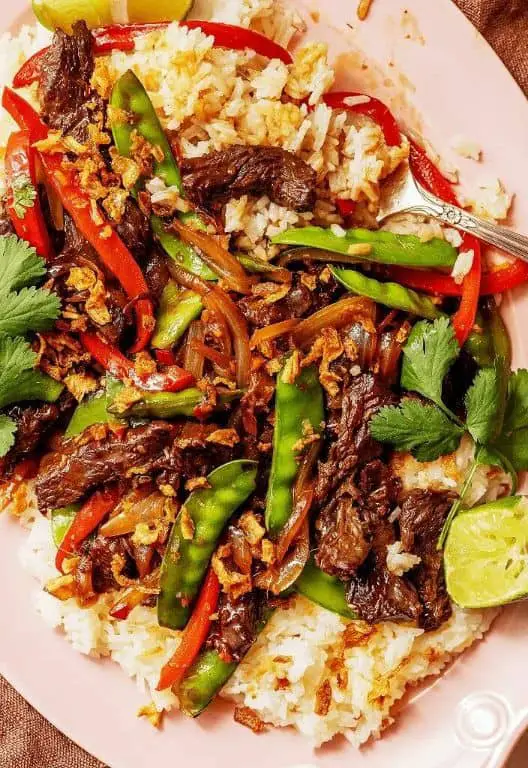
This fragrant stir-fry packs a punch with bright lemongrass and savory beef—perfect for a quick weeknight dinner that feels anything but ordinary.
Ingredients
- 1 lb flank steak, thinly sliced against the grain
- 3 tbsp vegetable oil, divided
- 2 stalks lemongrass, tender inner part only, finely minced (about 2 tbsp)
- 4 garlic cloves, minced
- 1 tbsp soy sauce
- 1 tbsp fish sauce
- 1 tsp sugar
- 1/2 tsp black pepper
- 1 small red bell pepper, thinly sliced
- 1/4 cup water
- 2 green onions, sliced (for garnish)
Instructions
- In a bowl, toss the beef with 1 tbsp vegetable oil, soy sauce, fish sauce, sugar, and black pepper. Let marinate for 10 minutes.
- Heat 2 tbsp vegetable oil in a large wok or skillet over high heat. Add the lemongrass and garlic, stir-frying for 30 seconds until fragrant.
- Add the beef in a single layer and cook undisturbed for 1 minute, then stir-fry for another 2 minutes until browned but still slightly pink.
- Toss in the bell pepper and water, stir-frying for 1–2 minutes until the pepper softens slightly and the sauce thickens.
- Garnish with green onions and serve immediately over rice.
The magic here? Lemongrass’s citrusy zing cuts through the rich beef, while the quick marinade locks in bold flavor without fuss.
Tip: Freeze the beef for 20 minutes before slicing—it’ll make paper-thin cuts a breeze!
Hmong Pumpkin and Taro Soup
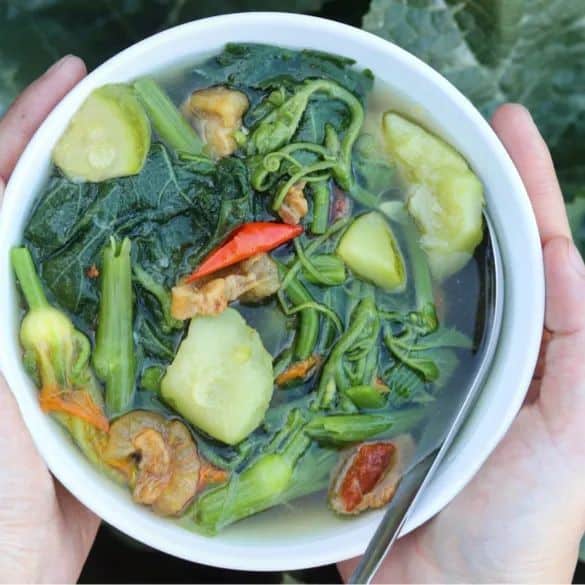
This comforting soup blends earthy taro and sweet pumpkin in a fragrant broth—simple to make but packed with soul-warming flavor.
Ingredients:
- 1 tbsp vegetable oil
- 1 small yellow onion, diced
- 3 cloves garlic, minced
- 1 lb boneless chicken thighs, cut into bite-sized pieces
- 4 cups chicken broth
- 2 cups peeled and cubed pumpkin (1-inch pieces)
- 2 cups peeled and cubed taro (1-inch pieces)
- 1 tbsp fish sauce
- 1 tsp salt
- 1/2 tsp black pepper
- 2 green onions, thinly sliced
- Handful of fresh cilantro, chopped
Instructions:
- Heat 1 tbsp vegetable oil in a large pot over medium heat. Add onion and sauté for 3 minutes until translucent. Stir in garlic and cook for 30 seconds until fragrant.
- Add chicken and cook for 5 minutes, stirring occasionally, until no longer pink.
- Pour in 4 cups chicken broth, then add pumpkin and taro. Bring to a boil, then reduce heat to low and simmer for 20 minutes, partially covered, until vegetables are tender.
- Season with 1 tbsp fish sauce, 1 tsp salt, and 1/2 tsp black pepper. Simmer for 2 more minutes.
- Garnish with green onions and cilantro before serving.
The taro thickens the broth slightly while the pumpkin keeps it subtly sweet—a cozy balance that makes this soup stand out.
Tip: For extra depth, char the pumpkin cubes lightly in a dry skillet before adding them to the pot.
Hmong Grilled Tilapia with Herbs

This fragrant, herb-packed tilapia is a showstopper—charred on the grill yet bursting with fresh, citrusy flavors. Perfect for summer nights when you want something light but full of personality.
Ingredients:
- 2 whole tilapia (about 1 lb each), cleaned and scaled
- 3 tbsp vegetable oil, divided
- 1 tsp salt
- 1 tbsp sugar
- 2 tbsp fish sauce
- 1 lime, juiced (about 2 tbsp)
- 1/2 cup chopped cilantro
- 1/2 cup chopped green onions
- 1/4 cup chopped mint
- 3 cloves garlic, minced
- 1 Thai chili (or serrano), thinly sliced (optional)
Instructions:
- Prep the fish: Pat tilapia dry, then rub with 1 tbsp vegetable oil and sprinkle evenly with 1 tsp salt inside and out.
- Make the herb mix: In a bowl, whisk together 2 tbsp vegetable oil, 1 tbsp sugar, 2 tbsp fish sauce, and lime juice. Stir in cilantro, green onions, mint, garlic, and chili (if using).
- Grill: Heat grill to medium-high (400°F). Grill tilapia for 5–6 minutes per side, until skin is crisp and flesh flakes easily.
- Serve: Transfer fish to a platter and spoon herb mix generously over the top. Serve immediately with steamed rice.
The magic here? The herbs stay bright and crunchy against the smoky fish—no heavy marinades needed. Tip: For easier flipping, lightly oil the grill grates and use a fish spatula.
Conclusion
From savory stews to vibrant salads, these 19 authentic Hmong recipes bring bold flavors and cultural richness to your kitchen. Whether you’re new to Hmong cuisine or a longtime fan, we hope these dishes inspire your next meal. Try a recipe, share your favorite in the comments, and don’t forget to pin this roundup for later—happy cooking!

I’m Brandon, the face behind the recipes. As a dedicated food enthusiast, I love experimenting with flavors and sharing my culinary adventures with you.


